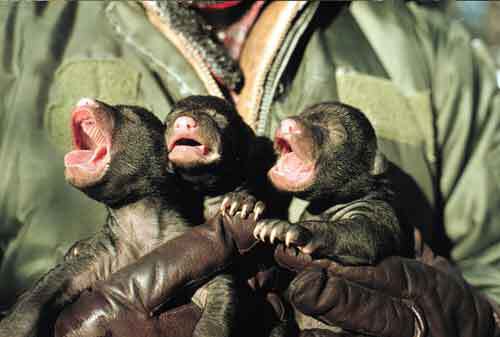

A day in the life of a spring black bear
Article originally written in 1997.
Imagine, for a few minutes, that you are not reading a newspaper science column. Pretend it's springtime in Alaska, and you are a black bear living somewhere between Ketchikan and the southern flanks of the Brooks Range. You have slept fitfully for the past six months, stirring on occasion to roll over, or, if you're a pregnant female, to give birth to cubs. Your body temperature, about 92 degrees Fahrenheit during your six months in the den, will soon rise to its normal 100 degrees.
You somehow sense that it's time for a change. Perhaps prompting you is the persistent sunlight that strikes the snow covering your den. Maybe meltwater collecting in your nest-like bed wakes you, and reminds you of how uncomfortable you are. Whatever the reason, you nose toward the light and paw at the framework of twigs you pulled over the entrance to the den months ago.
After digging away the twigs, you push at the blanket of snow that has covered your den during Alaska's fall, winter, and early spring. With a little shoving and scraping, you break through to blue sky. The air tastes cool and fresh compared to the stuffy den.
You pull yourself skyward, creating a tunnel of snow and earth that is a little more than a foot wide. Sluggish, you stand on four stiff legs, feeling the warmth of the sun for the first time in half a year. If you are a healthy bear, you are one of the first to emerge from the den. Less healthy, skinnier bears come out next, followed by mother bears with cubs. Tiny, woolly cubs, born in January and early February, weigh a few pounds each.
You stumble into spring air and sunshine. Walking hurts your feet; you shed your callused footpads from the previous year, and the new skin needs toughening. Seeing a dry spot under a nearby spruce tree, you lightfoot over and plop down like a tired dog.
Your body slowly reacts to the small amount of activity you've just performed. You feel the need to use functions that were shut down during the last half-year. For example, you haven't urinated or defecated since entering the den in late September. While you were curled up, your liver and kidneys recycled your urine. Your kidneys have filtered your blood of impurities, which are normally released as urine. While hibernating, however, your urine was reabsorbed back into your bloodstream. The urine flowed to your liver, which converted it to useful amino acids.
Your now-empty den is spotless. You haven't defecated there because you can't. Your intestinal pathway is plugged with dried fecal matter. The discomfort of your digestive tract terminus and your empty stomach inspire you to search for food and water. A melt puddle suffices for water and last year's low-bush cranberries, popping through the melting snowpack, explode with tartness in your mouth. The succulent greens of wild grasses and ferns will make up much of your diet soon, but snow still covers much of your groggy world.
When the greens are available, your diet will consist almost entirely of vegetation, which will serve to jump-start your digestive system. Later, in perhaps a week, your nose will lead you to a smelly salmon carcass you missed in the fall. You wander from the den site, following your nose to other prizes. You fill your belly. The sun shines. It's a great time not to be hibernating in Alaska.
You are no longer a bear. You are a person, reading a newspaper column, which I wrote with bear facts and speculations from Mark Bertram, a U.S. Fish and Wildlife Service wildlife biologist; Erich Follmann, a professor of zoology at the University of Alaska Fairbanks' Institute of Arctic Biology; and Don Young, a biologist with the Alaska Department of Fish and Game in Fairbanks.






